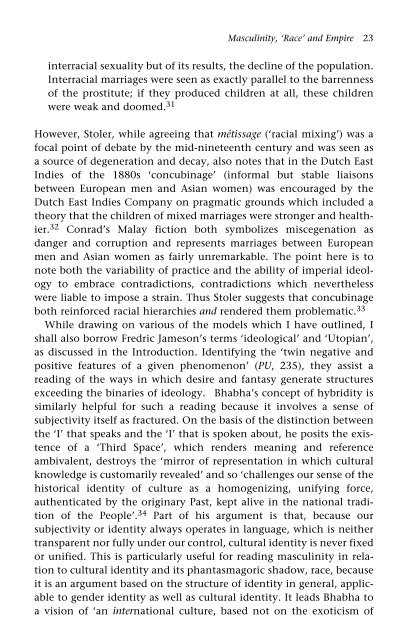Conrad and Masculinity
Conrad and Masculinity
Conrad and Masculinity
You also want an ePaper? Increase the reach of your titles
YUMPU automatically turns print PDFs into web optimized ePapers that Google loves.
<strong>Masculinity</strong>, ‘Race’ <strong>and</strong> Empire 23<br />
interracial sexuality but of its results, the decline of the population.<br />
Interracial marriages were seen as exactly parallel to the barrenness<br />
of the prostitute; if they produced children at all, these children<br />
were weak <strong>and</strong> doomed. 31<br />
However, Stoler, while agreeing that métissage (‘racial mixing’) was a<br />
focal point of debate by the mid-nineteenth century <strong>and</strong> was seen as<br />
a source of degeneration <strong>and</strong> decay, also notes that in the Dutch East<br />
Indies of the 1880s ‘concubinage’ (informal but stable liaisons<br />
between European men <strong>and</strong> Asian women) was encouraged by the<br />
Dutch East Indies Company on pragmatic grounds which included a<br />
theory that the children of mixed marriages were stronger <strong>and</strong> healthier.<br />
32 <strong>Conrad</strong>’s Malay fiction both symbolizes miscegenation as<br />
danger <strong>and</strong> corruption <strong>and</strong> represents marriages between European<br />
men <strong>and</strong> Asian women as fairly unremarkable. The point here is to<br />
note both the variability of practice <strong>and</strong> the ability of imperial ideology<br />
to embrace contradictions, contradictions which nevertheless<br />
were liable to impose a strain. Thus Stoler suggests that concubinage<br />
both reinforced racial hierarchies <strong>and</strong> rendered them problematic. 33<br />
While drawing on various of the models which I have outlined, I<br />
shall also borrow Fredric Jameson’s terms ‘ideological’ <strong>and</strong> ‘Utopian’,<br />
as discussed in the Introduction. Identifying the ‘twin negative <strong>and</strong><br />
positive features of a given phenomenon’ (PU, 235), they assist a<br />
reading of the ways in which desire <strong>and</strong> fantasy generate structures<br />
exceeding the binaries of ideology. Bhabha’s concept of hybridity is<br />
similarly helpful for such a reading because it involves a sense of<br />
subjectivity itself as fractured. On the basis of the distinction between<br />
the ‘I’ that speaks <strong>and</strong> the ‘I’ that is spoken about, he posits the existence<br />
of a ‘Third Space’, which renders meaning <strong>and</strong> reference<br />
ambivalent, destroys the ‘mirror of representation in which cultural<br />
knowledge is customarily revealed’ <strong>and</strong> so ‘challenges our sense of the<br />
historical identity of culture as a homogenizing, unifying force,<br />
authenticated by the originary Past, kept alive in the national tradition<br />
of the People’. 34 Part of his argument is that, because our<br />
subjectivity or identity always operates in language, which is neither<br />
transparent nor fully under our control, cultural identity is never fixed<br />
or unified. This is particularly useful for reading masculinity in relation<br />
to cultural identity <strong>and</strong> its phantasmagoric shadow, race, because<br />
it is an argument based on the structure of identity in general, applicable<br />
to gender identity as well as cultural identity. It leads Bhabha to<br />
a vision of ‘an international culture, based not on the exoticism of




